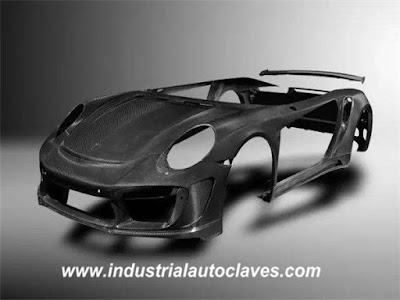What are the stages of the composites autoclave curing process? The following describes 6 stages of composites autoclave curing process and the technical points of each stage.
1. Heating stage of composites autoclave. Choosing a reasonable heating rate is the first step. For large composite parts, the heating should be slow so that the whole part is evenly heated, 2℃/min is the commonly used heating rate. This stage mainly uses the vacuum pressure which depends on the curing situation.
2. Adhesive stage of composites autoclave. In fact, it is an intermediate insulation stage which holds different temperature and time for different resin substrates. The main purpose of this stage is to melt the resin, impregnate the fiber, remove volatiles, and gradually solidify the resin into a gel state. The molding pressure at this stage is 1/3~1/2 of the total pressure, part of the resin is discharged to ensure that the final resin content of the parts meets the design requirements.
3. Continuous heating stage of composites autoclave. After the stage of adhesive absorption, the resin matrix has been semi-cured, solvent and low molecular weight volatiles are fully discharged, the curing temperature sublimates to the designated degrees and keep a certain while. The curing reaction of thermosetting resin is the exothermic reaction. During the curing process, heat is released. If the composites autoclave temperature rises too fast, the curing reaction speed will be accelerated rapidly, a large amount of heat is released and will lead to the local burning of the material, this phenomenon is called detonation and must be avoided.
2. Adhesive stage of composites autoclave. In fact, it is an intermediate insulation stage which holds different temperature and time for different resin substrates. The main purpose of this stage is to melt the resin, impregnate the fiber, remove volatiles, and gradually solidify the resin into a gel state. The molding pressure at this stage is 1/3~1/2 of the total pressure, part of the resin is discharged to ensure that the final resin content of the parts meets the design requirements.
3. Continuous heating stage of composites autoclave. After the stage of adhesive absorption, the resin matrix has been semi-cured, solvent and low molecular weight volatiles are fully discharged, the curing temperature sublimates to the designated degrees and keep a certain while. The curing reaction of thermosetting resin is the exothermic reaction. During the curing process, heat is released. If the composites autoclave temperature rises too fast, the curing reaction speed will be accelerated rapidly, a large amount of heat is released and will lead to the local burning of the material, this phenomenon is called detonation and must be avoided.
4. Thermal insulation and pressure stage. At this stage, the resin curing temperature is preset, resin matrix need to be further curing, this stage to add full pressure, the purpose is to make the resin in the process of continued curing between the layers of sufficient compaction. From the total pressure to the end of the whole hot press is known as the hot press stage. The time from reaching the specified of composites autoclave curing process, hot pressing temperature to the end of hot pressing is called constant temperature time. The temperature, pressure and constant temperature time in the hot pressing stage are important technological parameters in the molding process, which must be strictly controlled according to the formula of the resin matrix used.
5. Cooling Stage. Under certain pressure retention conditions, natural cooling or forced cooling should carry out to a certain temperature or room temperature, and then pressure is released before taking out the product. It will be easy to make the product warping, cracking and other phenomena if the cooling time is too short. If the cooling time is too long, it will make the production cycle longer and will not help to the product quality.
5. Cooling Stage. Under certain pressure retention conditions, natural cooling or forced cooling should carry out to a certain temperature or room temperature, and then pressure is released before taking out the product. It will be easy to make the product warping, cracking and other phenomena if the cooling time is too short. If the cooling time is too long, it will make the production cycle longer and will not help to the product quality.
6. The final stage is also known as the processing stage. The high temperature is used to cure parts, the temperature should be cool down slowly and to keep the low temperature for a period of time, so the internal stress of the finished parts can eliminated which is caused by the high temperature, and the deformation of parts after unloading can be ideally prevented.
Taian Strength Equipments Co, Ltd has been dedicated to manufacturing and supplying supercritical equipment, composite autoclave, industrial autoclaves, storage tank, dished head, hydrogenation reactor equipment and custom pressure vessel products and solutions to worldwide customer over 20 years. We have 80 talented research and development experts and 2 million square meters factory. Our annual pressure vessel output can reach 300 sets, dish head 3000 sets. Hope to be your partners.






没有评论:
发表评论